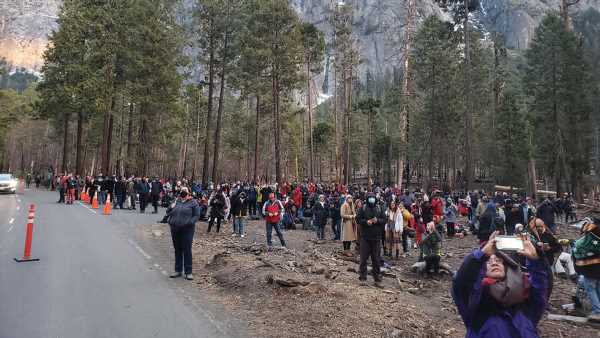
Despite a drop-off in visitation this summer, overcrowding and congestion still dampened the visitor experience at many U.S. national parks.
But this time, Mother Nature was mostly to blame.
Yellowstone and Yosemite were among the parks where extensive traffic and long lines at entrances were a problem, despite a decrease in visitation compared with summer 2022. And while several factors were at play, the main one was the residual effects of last year’s harsh winter and record snowfall in much of the Western U.S.
“There have been some significant weather challenges in snowfall and precipitation, which forced prolonged road closures in the region,” said Jonathan Farrington, CEO of the Yosemite Mariposa County Tourism Bureau in California.
A number of major access roads to Yosemite that usually close only from November to May or early June stayed shut well into the peak summer travel season because of record-breaking snowfall and a melting snowpack that caused severe flooding and extensive road damage, Farrington said. Some roads remained closed into July, representing the park’s latest opening date since at least 1980, Farrington said, leading to “less-than-favorable traffic conditions in Yosemite Valley.”
The most significant impact came from the extended closure of Highway 120 and its Big Oak Flat park entrance, he added, “which forced vehicles to just two of the four entrances into Yosemite Valley.”
Yellowstone and the Grand Canyon also had their fair share of weather-related issues, which Tauck said impacted the opening of some of the park properties.
“This year, a few of those properties have been faced with some challenges, mostly related to extreme weather events that damaged roads, limited access to some of the parks and delayed the openings of some of the parks’ lodges where we stay,” said Tauck COO Jeremy Palmer.
Among them is the Grand Canyon Lodge North Rim, which delayed its opening due to a 300-foot section of water main destroyed during a winter avalanche. In Yellowstone, Palmer said, the Mammoth Hot Springs Hotel was closed for the early part of the season because of weather-related delays to repair its wastewater treatment system.
The crowding and traffic occurred despite tour operators and some national parks reporting a decline in bookings this summer.
Intrepid said Yellowstone trips were down 13% this past May compared with May 2022. The company said it experienced lighter crowds there this summer.
“We have definitely seen a softening of domestic national park travel and a shift toward international travel,” said Scott Cundy, marketing director at Intrepid. “Coinciding with the 10% decrease in domestic bookings from 2022, we’ve seen a 17% increase in international bookings over last year.”
The Yosemite Mariposa County Tourism Bureau said Yosemite visitation from January to June decreased compared with the same period of 2022.
Should those visitor levels return to higher levels, tour operators hope the parks focus on other reasons for congestion this year.
“Some national parks, such as Rocky Mountain National Park, implemented a timed entry system during Covid and have kept it in place, reducing crowding and improving the visitor experience into 2023,” Cundy said. “Other parks, such as Yosemite, stopped using their Covid timed-entry systems, and it has been like opening the floodgates.”
Yosemite ended the timed reservation system last year. While it was in place, tour operators said, there was no vehicle congestion in the Yosemite Valley and far fewer instances of overcrowding.
Seeing the stark contrast in visitors’ experience prompted the park to seek out new visitor-management solutions. Park officials are currently working on a plan addressing road and parking congestion, long waits at entrances and vegetation impacts from cars parked in nonparking areas. Potential solutions include reservations for entrance during peak summer hours, parking lots, reservations for events and timed entrances.
Yosemite also opened a public comment period for its Visitor Management Plan, a move the National Tour Association (NTA) praised as the right step to improve the visitor experience at a community level.
“We actually mobilized some of our motorcoach tour operators to provide comment,” said Catherine Prather, president of the NTA.
Referencing photos Yosemite released illustrating park congestion, she said, “They were all single-vehicle cars. So if you take a motorcoach of 40 to 50 people, you’re going to be replacing anywhere up to, say, 30 to 40 single-use vehicles. That can significantly help with congestion.”
Intrepid’s Cundy said he hopes Yosemite will start with bringing back its reservation system, adding that the one in place during Covid “had a tremendously positive impact on overcrowding, the quality of the visitor experience and the well-being of the park’s ecosystems and infrastructure.”
Source: Read Full Article










